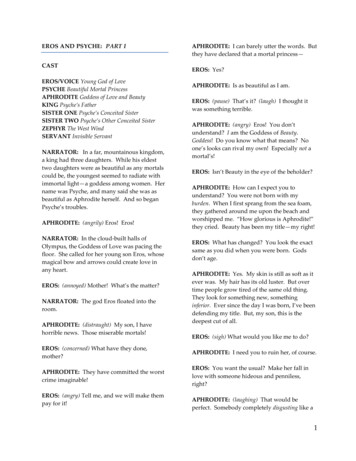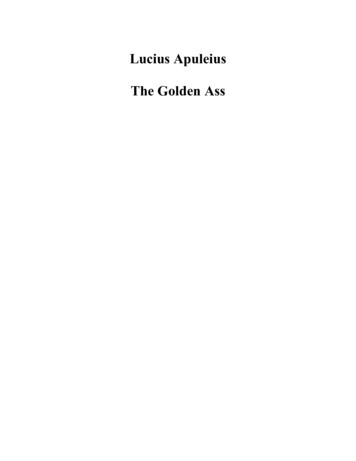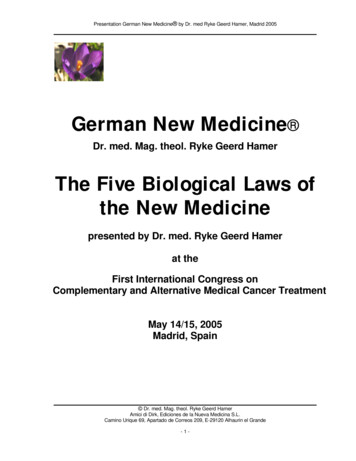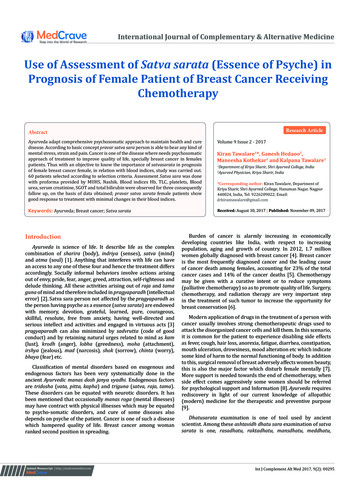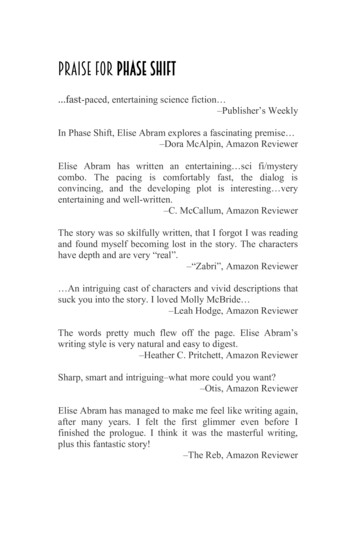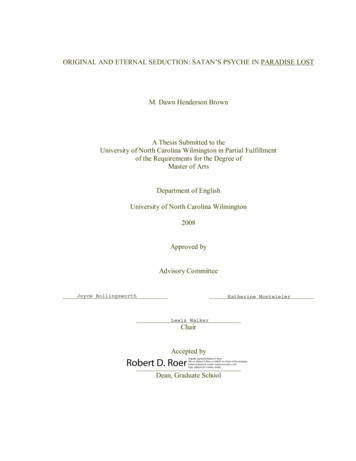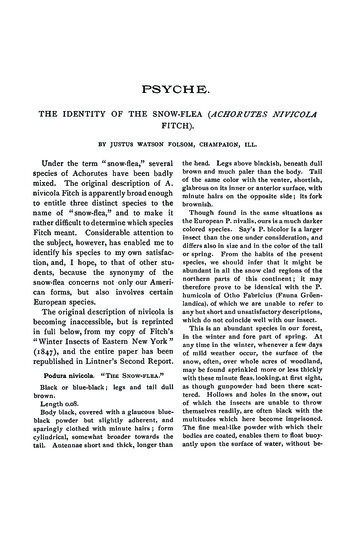
Transcription
PSYCHE,THE IDENTITY OF THE SNOW-FLEA (4C2r-ZORUZ’ES 2VZKZCOL4FITCH).BYJUSTUSWATSONFOLSOM CHAMPAIGNUnder the term "snow-flea," severalspecies of Achorutes have been badlymixed. The original description of A.nivicola Fitch is apparently broad enoughto entitle three distinct species to thename of "snow-flea," and to make itrather difficult to determine which speciesFitch meant. Considerable attention tothe subject, however, has enabled me toidentify his species to my own satisfaction, and, I hope, to that of other students, because the synonymy of thesnow-flea concerns not only our American forms, but also involves certainEuropean species.The original description of nivicola isbecoming inaccessible, but is reprintedin full below, from my copy of Fitch’s"Winter Insects of Eastern New York "(I847), and the entire paper has beenrepublished in Lintner’s Second Report.Podura nivicola."THE SNOW-I’LEA?Black or blue-black; legs and tail dullbrown.Length o.oS.Body black, covered with a glaucous blueblack povder but slightly adherent, andsparingly clothed with minute hairs; formcylindrical, somewhat broader towards thetail. Antennae short and thick, longer thanILL.the head. Legs above blackish, beneath dullbrown and much paler than the body. Tailof the same color with the venter, shortish,glabrous on its inner or anterior surface, withminute hairs on the opposite side; its forkbrownish.Though found in the same situations asthe European P. nivalis, ours is a much darkercolored species. Say’s P. bicolor is a largerinsect than the one under consideration, anddiffers also in size and in the color of the tailor spring. From the habits of the presentspecies, we should infer that it might beabundant in all the snow clad regions of thenorthern parts of this continent; it maytherefore prove to be identical with the P.humicola of Otho Fabricius (Fauna Gr6enlandica), of which we are unable to refer toany but short and unsatisfactory descriptions,which do not coincide well with our insect.This is an abundant species in our forest,in the winter and fore part of spring. Atany time in the winter, whenever a few daysof mild weather occur, the surface of thesnow, often, over whole acres of woodland,may be found sprinkled more or less thicklywith these minute fleas, looking, at first sight,as though gunpowder had been there scattered. Hollows and holes in the snow, outof which the insects are unable to throwthemselves readily, are often black with themultitudes which here become imprisoned.The fine meal-like powder with which theirbodies are coated, enables them to float buoyantly upon the surface of water, without be-
316t-’S YCH.E.coming wet. When the snow is 1nelting soas to produce small rivulets coursing alongthe tracks of the lumberman’s sleigh, thesesnow-fleas are often observed, floating passively in its current, in such numbers as toform continuous strings; whilst the eddiesand still pools gather them in such myriadsas towholly hide the element beneath them.Fitch’s types of Collembola are notknown to exist, so Dr. Felt wrote me.Fitch’s manuscript notes on the order,which belong to the Boston Society ofNatural History, I have read and copied,thanks to Mr. Samuel Henshaw; theycorrect the original description thus""The antennae and legs are the samecolor as the body, not reddish or deepbrown." (Fitch appears to have hadPodura aquatica in mind, in the firstHe adds, "In the earlyinstance.)spring the buckets and troughs of themanufacturer of maple sugar are oftenthronged with these insects."Although the description of Poduranivicola is less specific than is desirable,and has consequently been the sourceof some confusion,-- nevertheless, theevidence which I have collected leavesno reasonable doubt in my mind, as tothe identity of Fitch’s species.Three species (here called nivicol,]mrveyi, and 2ac/Sardi) have been andmay be confused, on account of theirsuperficial agreement in form and color,--and only three have any claim to thename of nivicola. These three are notonly sharply separated by structural details, but are also so different in time ofappearance, abundance, habitat, andhabits that they can be determined in[March,x9o2the field. The form that I have redescribed as nivicola is the only onethat agrees with the original descriptionin being abundant at any time duringthe winter,-- and it may be dependedupon to occur in immense numbers everyyear, in the manner described by Fitch.Harveyi seldom appears before the firstof March, in Massachusetts, where itoccurs on the trunks of pine and othertrees in but moderate numbers. I haveit as a "snow-flea" from Maryland, buthave never been able to find it as suchin M:assachusetts, Maine, or New York.Specimens collected for me in a sugarcamp in Maine, for the purpose of thisdiscussion, proved to be what I hadcalled nivicola. Finally, Mr. MacGillivray, in response to my request, sent me"snow-fleas" from Osceola, Penn., andOtto, N. Y., saying, The one from Otto,N. Y., is the common New York species."Both lots consisted of the species that Ihad already regarded as the real nivicola.Packard’s redescription of nivicola,which subsequent writers have substituted for Fitch’s diagnosis, cannot applyto the nivicola established above, on account of the disagreement as to mucronesand anal spines; moreover, nivicola hasdisappeared from Salem and vicinity byMay 7, at the latest,while Packardgives May 28 and June 6 as two of histhree dates. It does not apply toharveyi, for that does not occur muchafter April 2, except in the egg. Onlyone species remains to which it might,and does, apply. Packard’s specimensof nivicola are lost, unfortunately, but
March,S YCZ-Z.among some unpublished figures (whichhe kindly gave me), of his Essex Countyspecies, are camera-lucida drawings ofevery essential detail (claws, mucrones,anal spines, etc.) of his nivicola, a formwith which I am familiar, and one thatcannot be the nivicola of Fitch, on account of appearing too late, if for noother reason. The species which Packard called nivicola, is new and is herenamed packardi.Lintner repeated Fitch’s account ofnivicola, supplementing it with Packard’sdescription, upon the assumption thatthe two descriptions referred to the samespecies, and added several notices byothers upon the occurrence of snowfleas." Later, Dr. Lintner (’96, pp. 25xto 252 ) found that doubt attended thename of nivicola, and, still assumingthat Packard’s redescription was valid,figured a form from Ghent, N. Y., whichagreed with it this form is actually thatwhich Packard described as nivicola, asI have learned from some of the originalGhent specimens, which were sent meby Dr. Felt. The Schoturus nivicola ofLintner’s Eleventh Report, then, isAchorutes packardi n. sp.The same report (pp. 253 to 254)contains the description of Achorutesdiversiceps Lintn. The types of diversleeps, that were loaned to me by Dr.Felt, confirm my conclusion, drawn fromLintner’s description and figures, thatdiversiceps is the form that Fitch namednivicola.Harvey (’93, PP. 83, 84), withoutquestioning the applicability of Pack-317ard’s redescription, gave two full formfigures to supplement Packard’s account.I now have the specimens from whichthose figures were made, and find themto be Packard’s species, indeed, and,therefore, not the nivicola of Fitch.The queried references in the synonymy below are to popular notices uponinsects that are probably, but not unquestionably, the snow-flea described byFitch.A. nivicola Fitch occurs in Europeunder the names socialis Uzel and s2Oinijr SchS.f. Three Swedish examples ofsocialis which were determined by Sch6ttand sent me by Schiffer, agree accurately with our nivicola. Sch6tt (’94,p. 82), in fact, adds to his detailed account of socialis, Es ist nicht unwahrscheinlich dass die yon Packard beschriebene Achorutes nivicola, die er meinerAnsi,cht nach aus guten Grunden mitFitch’s Podura nivicola gleichstellt, keineandere als 0bige Art sei." This surmise,incorrect as to the supposed equivalenceof Packard’s and Fitch’s species, is correct as regards the identity of socialisUzel and nivicola Fitch.I sent American specimens to Dr.Schffer, who replied, "Achorutes nivicola Fitch erweist sich in den Formmerkmalen mit meinem Achorutes spiniferubereinstimmend. Ach. spiniferist darnach eine (kleinere) FarbenvarietRtvon A. nivi.cola Fitch."A. nivicola is closely allied to /.harveyi n. sp., from which it may beseparated by its stout superior claws,ovate inferiors, small anal spines on a
8182S YCZIE.cylindrical segment, and clothing of longsubequal setae.Each of the three species discussedabove is characterized below. Unlessotherwise specified, the material referredto was collected by the author, and isowned by him; examples of each species,however, have been given to the Museum of Comparative ZoSlogy, Cambridge,Mass.Ackorutes nivicola Fitch.(Figs. -x .)Podura nivicola Fitch, Amer. Journ.Sc. Agric., vol. 5 (847)pp. 283--84 andvol. 6 (847) p. 52; Winter Ins. E. N.Y. (847) PP. o- (reprinted by Lintnet, Second Rept. (885) pp. 2o4, 205,244. Fitch, Rural New Yorker, vol.8 (,857).McMinn, Proc. Acad. Nat.Sc. Phila., vol. 4 (x849) P. 246.Ashton, Proc. Ent. Soc. Phila., vo!. ( 86 x)p. 32 (repr. Lint. Sec. Rept., p. 2o4).Walsh, Riley, Amer. Ent., vol. ( 869)Field and Forest, vol.p. I88.(877) PP. 46-x47 (repr. Lint. Sec.Rept., p. 205).Achorules socialis Uzel, Thys. Boh.[March,burg (I896) pp. 72, 74, tar. 3, fig. 5x.Achorules diversiceps Lintner EleventhKept. (i896) pp. 253-254 figs. 23-25.(Ref. to Country Gentleman, Mar. 2.,x879, P. 327.)Dark indigo blue throughout (fig. ). Eyes(fig. ) sixteen. Postantennal organs (fig. 3)of four elements. Antennae (fig. 4) almost aslong as the head, with segments as 7 9 o 5basal segment subglobose, second and thirdsubcylindrical,fourth rounded conical. Bodyelongate, abdomen subfusiform, last segmentcylindrical. Superior claws (fig. 5) stout,slightly curved, unidentate two fifths fromthe apex; inferior claws half as long, basallysubovate, apically acicular one long tenenthair with a minute knob; distal tibial hairsminutely knobbed. Manubrium as long as therest of the urcula; dentes (.figs. 6, 7) stout,subcylindrical, apically broad and rounded,bearing four to six prominent, acutely conicalteeth, of which one is more lateral than theothers in addition, there are usually fifteento seventeen small outer teeth; mucrones(fig. 8) inserted on inner side of the apex ofeach dens and rather boat-shaped; in profile,suboblong, feebly curved, apex retuse oremarginate. Anal spines (figs. 9, IO) two,small, conical, erect, upon low, separatedpapillae. Clothing (fig. II) of numerouslong curving hairs and few short curvedsetae. Length, 2 ram.Norway, Maine, May 7, F. Howe, Jr.;(x89o) pp. 69-70, tab. 2, figs. x6- 9.SchStt, Syst. Verb. (894) pp. 8-82, Orono, Maine, March, April S, May 6,taf. 7, figs. 6-8. .Schffer, Coll. Hamburg (896) p. 72.Achorules nivicola MacGillivray, Can.Ent., vol. 23 (89) p. 274.ScAolurus nivicola MacGillivray, Can.Ent., vol. o. 5 (893) p. 36. DallaJ’orre, Gatt. Arten Apt. (I89) p.AcAorutes s2inifer Schffer, Coil.Ham-F. L. Harvey. Arlington, Massachusetts, April 2, Belmont, Massachusetts,April 9, May 5 Winchester, Massachusetts, February 9, R. W. Hall; Karner,New York, April 26, A. Lintner (N.Y. State Coll.); Otto, New York, J. H.Comstock; Osceola, Pennsylvania, A.D. MacGillivray.
Poe YCIIE.March,Acioruges 2aackardi(Figs.2-sp. n.8.)Lintner319dependeduponPackard’saccount of nivicola, and the specimens towhich they applied that name are, indeed,the same species that Packard had inhand. this I have learned from an4chorules nivicola Packard, Thys.Essex Co. (873) pp. 29-.30. LintnerSecond Kept. (t885)p. 203. MacGill- examination of the identical specimensivray, Can. Ent., vol. 23 (89x) p. 274. that Harvey and Lintner used in preparHarvey Ent. News, vol. 4 (893) P. ing the papers mentioned above in thesynonymy.83, figs. 5, 6.As I have good reasons (alreadyScholurus nivicola Lintner EleventhKept. (896) pp. 25r-.52 figs. 2, 22. given) for believing that the nivicola ofPackard is not that of Fitch, and needsDark indigo blue throughout. Eyes (fig. a new name, I gladly name itackarcli.12) sixteen. Post-antennal organs (figs. 13,Toronto,Ontario,R.26,June14) of four elliptical-oval elements. AntenCrew; Orono, Maine, February, F. L.nae shorter than the head, with segments asCambridge, Massachusetts,5 8:7: io basal segment globose, second Harveyand third slightly expanding, fourth subcy- April7 Lexington, Massachusetts,lindrical with rounded apex. Body subcyMay io, ii; Ghent, New York, Aprillindrical. Superior claws (fig. i5) broad,13, E. C. Powell (N. Y. State Coll.);almost straight, untoothed; inferior clawsof hind feet two fifths as long as the superiors, Newark, Maryland, January 24, Beckslender, lanceolate, acuminate of the remain- with (N. Y. State Coll.).ing feet, one fourth as long, small; tenentThis species is frequently found onhair stout, exceeding the large claw, apexred maple trees, crawling on the trunkbent. Manubrium as long as the rest of theor remaining under the bark or in crevifurcula; dentes (fig. I6) one sixth as long,oblong, distally rounded, terminating in an ces, especially about the base of a tree.upturned tooth. Anal spines (fig. I7) two, I have occasionally found it under thethree fifths as long as a superior claw, stout, bark of pine, oak, and apple trees, orfeebly curved, erect; upon contiguous papil- about the roots; or clustered under mosslae. Clothing (fig. I8) of many stout curvingon a stone. Full grown individualsserrate setae of moderate length and fewerlong erect capitate setae, more or less serrate. occur from mid April until the middle ofJune; a second brood begins to appearLength, 2 ram.late in June and has disappeared byThis is the species that Packard redes- the last of August. I have twice (Aprilcribed as nivicola Fitch. Packard’s 22, 29) found abundant eggs of thisspecimens are not in the Museum of species under the loose moist bark ofComparative Zo61ogy, with the rest of red maple roots, protected by the sod;his Essex County material, but I am in they were pale yellow, spherical, 35possession of his original drawings, micra in diameter, occurred in irregularwhich leave no doubt as to what species masses and hatched in a little under onehe regarded as nivicola. Harvey and month.
]S YCI-ZE.Achorules packardi, var. denlalus, var. n.(Figs. 9-z4.)In this variety all the superior claws(fig. 9) are unidentate, the mucrones(figs. o, x) are one fourth as long asthe dentes, slender and laterally lamellate, the anal spines (fig. zz) are slender,[Mttrch, 9ocan be proved,however, only by carefulbreeding experiments, which are difficultto conduct accurately with these insects.tcharules arveyi sp. n.(Figs. 25-34.)Dark indigo blue throughout. Eyes (fig.25) sixteen. Postantennal organs (figs. 26,27) of four elliptical-oval elements. Antennae(fig. 28) subeqtal to the head in length, withsegments as IO: 13:13:2o first two segmentssubclavate, last two subcylindrical. Bodyelongate, abdomen subfusiform. Superiorclaws (fig. 29) slender, tapering, slightlycurved, unidentate about one third from theapex; inferior claws less than half as long,basal half suboblong, apical half acicular;one long tenent hair with bent apex. Manubrium as long as the rest of the furcula;dentes stout, subcylindrical, apically broadand rounded, projecting beyond the bases ofthe mucrones, bearing two rows of teeth(fig. 3o), fourteen to twenty-five in number,which are variable in size, and are more orless confluent basally; five may be muchlarger than the others (fig. 3i), and sometimesno teeth are present; mucrones (fig. 31) onefourth as long as dentes, in profile suboblong,dorsally concave, apically emarginate. Analspines (figs. 3 33) two, long (almost as longas a superior claw), slender, feebly curved,upon prominent approximate papillae. Clothing (fig. 34) of numerous curving setae andfewer bowed hairs. Length, 2 mm.while the stout erect setae are either notcapitate (fig. z3), or else are obscurelycapitate on the posterior part of theabdomen (fig. z4). In all other respectsthe variety agrees with the typical form.Orono, Maine, March o, 5, MayF. L. Harvey Arlington, Massachusetts,April o, 3, 23, 30, May 23, Septembero; Ghent, New York, April 3, E. C.Powell (N. Y. State Coll.).This variety lives under the loose barkof pine, red maple, and oak trees, especially at the base of the roots, and sometimes occurs on snow. It has at leastthree broods, which mature at intervalsof six or seven weeks.Dentatus is a seasonal variety of packardi. Young individuals that hatchedMay 2o from eggs laid by the varietydentatus were not that variety, but werethe typical form, with bulbiferous setae,no teeth on the superior claws, and withlamellate mucrones. One of the fourThis species is much like nivicola,specimens from Ghent, N. Y., was the but differs chiefly in having slender suvariety dentatus, the others being the perior claws, suboblong inferiors, longtypical form.anal spines, and clothing of another type.This is the first record of seasonalOrono, Maine, F. L. Harvey; Arlingdimorphism among the Collembola, al- ton, Massachusetts, January 6, Marchthough I suspect that certain other speo, o, April 8, 9, i2; Annapolis,cies also assume disguises, according to Maryland, January S, C. E. Munroethe season in which they occur. This (. C. Z.).,,,
March, t9o2]tS YCI-IF.This species occurs, long before snowhas gone, in large colonies, under loosewet bark and under soil, in crevices atthe base of a tree. Although mostcommon on pine, it lives also on elm andapple. In mild weather, it wandersabout on the trunks of trees or on theground, and it occurred in enormousnumbers as a "snow-flea," in Maryland,as recorded above. Captive specimenslaid eggs between April 9 and April i3.821On April i2, i found abundant eggs ofthis species among a colony of adults atthe base of a white pine; the eggs werewhite, spherical, and deposited in irregular heaps.I have never been able to find thisspecies in its customary haunts at anytime of the year after April I2; it isprobably at least digoneutic, however,and may prove to be dimorphic.ON THE LIMITS OF THE FAMILY SATURNIIDAE, WITH ANOTE ON THE GENUS ROTHSCHILDIA.BY A. S. PACKARD, PROVIDENCE, R. I.The elimination of so many non-spinning genera from the Saturniidae as proposed in this paper leaves that familyvery much curtailed.As I pointed out some years ago, it isdivided in.to two subfamilies, of verysimple larval characters, i. e., whether thetwo dorso-median tubercles of the 8thabdominal segment of the larva remainseparate, or are united in a single median one.The subfamily Saturniinae, characterized by having six separate tubercles(the two median ones being separate)on the 8th abdominal segment, comprise the following genera, Perisomena,Cricula, Saturnia (I cannot see that CalaStudies on the transformation of moths of the familySaturniidae. Proc. Amer. Acad. Arts and Sciences, Boston,(n. s.) XX, p. 8. x893.saturnia mendocino differs from Saturnia),Heniocha, Loepa.The subfamily Attacinae was at thesame time characterized by the larvaehaving but five tubercles on the 8th abdominal segment, the median one beingdouble, resulting from the fusion of thetubercles belonging to the two dorsalseries. The imaginal characters bearout this arrangement.The following genera belong to thisgroup, beginning as heretofore with themost generalized forms, the exact se-quence being subject to farther modification: Copaxa, Opodiphtera, Tagoropsis, Syntherata, lZhodia, Rinaca, N eoris, Caligula, Graellsia, Argema, Actias,Tropaea, Antheraea, Telea, Metosamia,Callosamia, Samia, Epiphora, Philosamia, Rothschildia, Coscinocera, Attacus.
Psyche, Vol. 9.Plate 3.
EXPLANATIONFig.OFPLATE 3"Acharutes nivicola Fitch, x 25.2.Eyes of left side,3.Postantennal organ of left side, x 504.x 114.4.Antenna,5.Left hind foot, x 294.Left aspect of left mucro and end of dens, x 422.Left aspect of left mucro and end of dens, x 354’Concave aspect of left mucro, x 504.Extremity of abdomen, x 64.Anal spine, lateral aspect, x 434.Clothing, dorsum of first abdominal segment, x6.7.8.9.o.I.x78.II4.AchorzttesjSackardi, sp. n. Eyes of left side, x 294.Postantennal organ of left side, x 5o4" right side, x 5o4.Left hind foot, x 354." Dens and mucro, x 294.Anal spine, x 366.Clothing, dorsum of first abdominal segment, x294.vat. dentatus, var. n. Left hind foot, x 422.Left aspect of right mucro, x 366.Right aspect of left mucro, x 54.Anal spine, lateral aspect, x 422.Clothing, dorsum of first abdominal segment, x i4.Clothing, dorsum of third abdominal segment, x 4.25. Achorutes harveyi sp. n. Eyes of left side, x 78.26.Postantennal organ of right side, x 5o4x 5o427i2.28.2933.34.Antenna,x78.Right front foot, x 294.Left aspect of right dens and mucro, x 47.Right dens and mucro, x 294.Extremity of abdomen, x 64.Left anal spine, x 294.Clothing, dorsum of first abdominal segment, xI4.
International Journal ofPeptidesBioMedResearch InternationalHindawi Publishing Corporationhttp://www.hindawi.comVolume 2014Advances inStem CellsInternationalHindawi Publishing Corporationhttp://www.hindawi.comVolume 2014Hindawi Publishing Corporationhttp://www.hindawi.comVolume 2014Virolog yHindawi Publishing Corporationhttp://www.hindawi.comInternational Journal ofGenomicsVolume 2014Hindawi Publishing Corporationhttp://www.hindawi.comVolume 2014Journal ofNucleic AcidsZoologyInternational Journal ofHindawi Publishing Corporationhttp://www.hindawi.comHindawi Publishing Corporationhttp://www.hindawi.comVolume 2014Volume 2014Submit your manuscripts athttp://www.hindawi.comThe ScientificWorld JournalJournal ofSignal TransductionHindawi Publishing Corporationhttp://www.hindawi.comGeneticsResearch InternationalHindawi Publishing Corporationhttp://www.hindawi.comVolume 2014AnatomyResearch InternationalHindawi Publishing Corporationhttp://www.hindawi.comVolume 2014EnzymeResearchArchaeaHindawi Publishing Corporationhttp://www.hindawi.comHindawi Publishing Corporationhttp://www.hindawi.comVolume 2014Volume 2014Hindawi Publishing rch InternationalInternational Journal ofMicrobiologyHindawi Publishing Corporationhttp://www.hindawi.comVolume 2014International Journal ofEvolutionary BiologyVolume 2014Hindawi Publishing Corporationhttp://www.hindawi.comVolume 2014Hindawi Publishing Corporationhttp://www.hindawi.comVolume 2014Molecular BiologyInternationalHindawi Publishing Corporationhttp://www.hindawi.comVolume 2014Advances inBioinformaticsHindawi Publishing Corporationhttp://www.hindawi.comVolume 2014Journal ofMarine BiologyVolume 2014Hindawi Publishing Corporationhttp://www.hindawi.comVolume 2014
PSYCHE, THE IDENTITY OF THE SNOW-FLEA (4C2r-ZORUZ'ES 2VZKZCOL4 FITCH). BY JUSTUS WATSON FOLSOM CHAMPAIGN ILL. Under the term "snow-flea," several species of Achorutes have been badly mixed. The original description of A. nivicolaFitchis apparentlybroadenough to entitle three distinct species to the name of "snow-flea," and to make it ratherdifficult todeterminewhichspecies Fitch meant.
